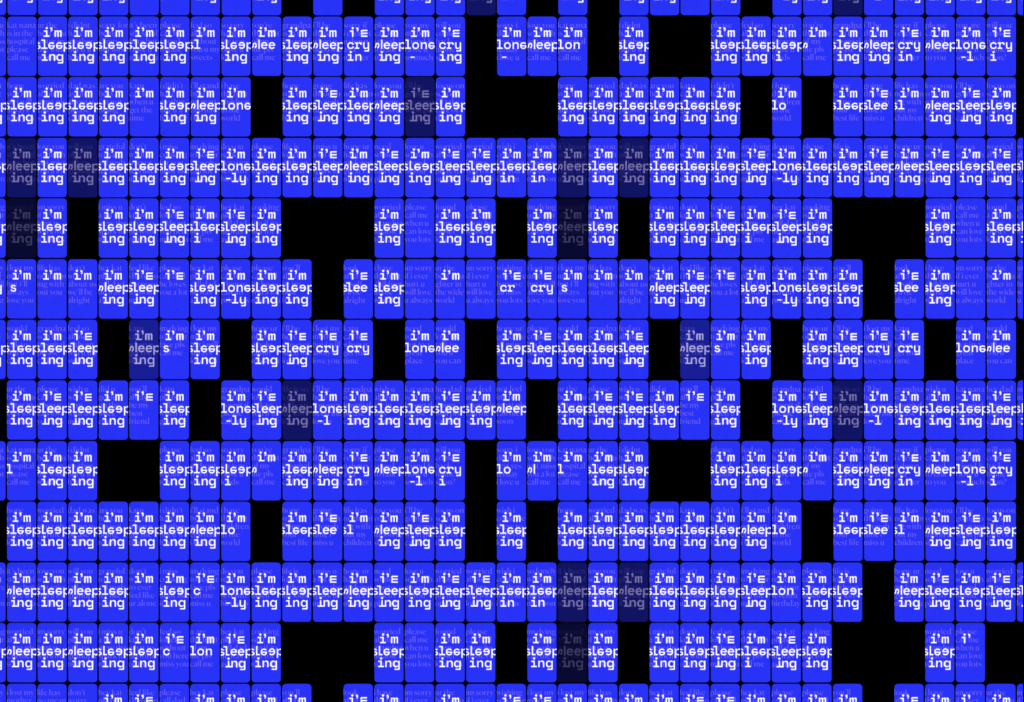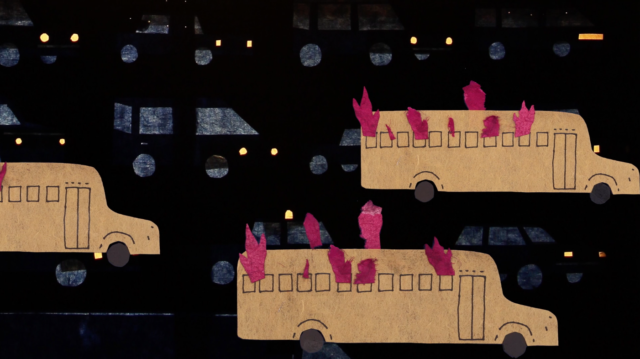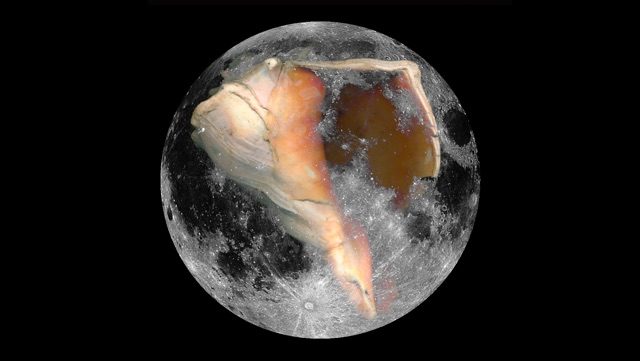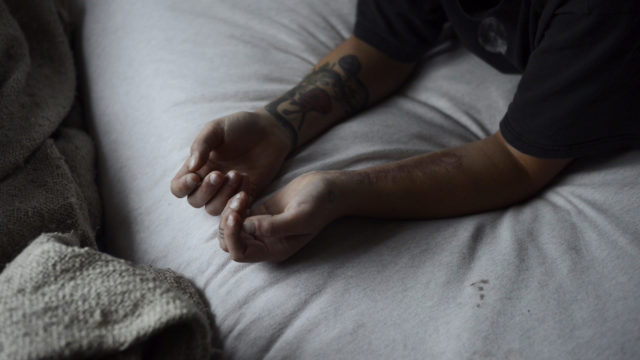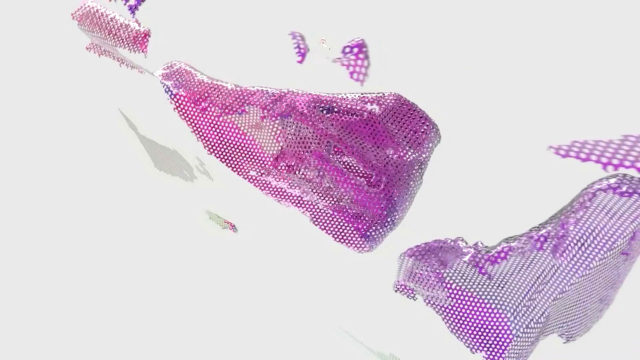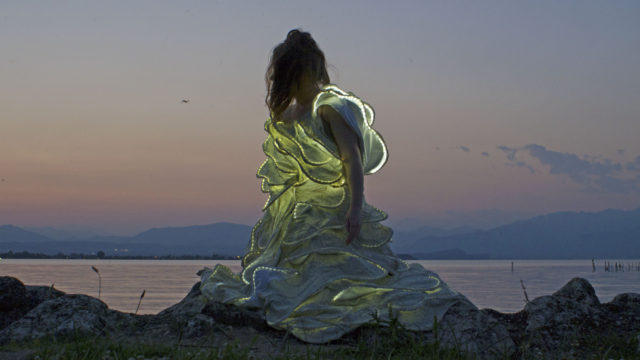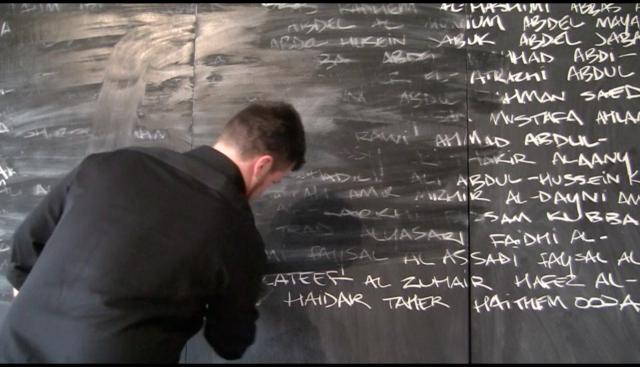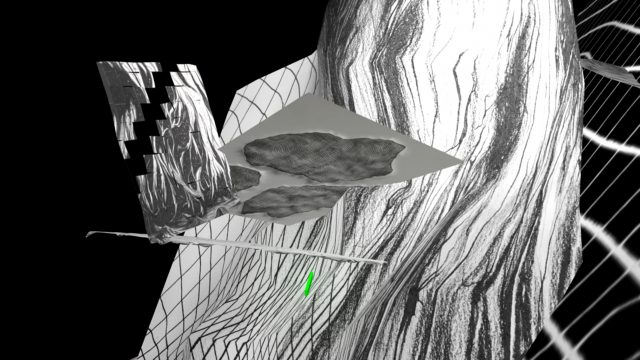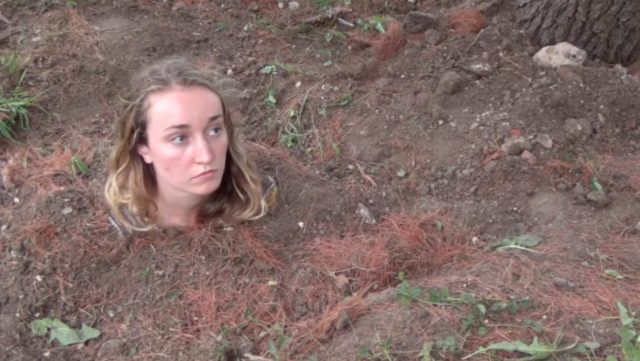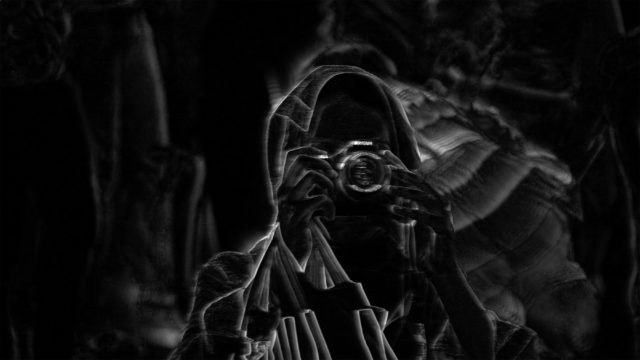Various Artists
Recent Digital Art Acquisitions
Van Every Gallery
On View: June 03, 2019— July 17, 2019
Over the past few years, in conjunction with the large Video Wall at the E. Craig Wall Jr. Academic Center and the addition of faculty focused on new media, the Van Every/Smith Galleries and Davidson College have committed to acquiring more digital works. Eighteen recent acquisitions are on display for the summer by nationally and internationally acclaimed artists below. Works represent diverse ideas and techniques from cheeky animations to more serious performative, politically engaged works.
Elizabeth Tolson The Discovery of Venus, 2017, HD Digital Video
Venus, the goddess of sex, beauty, and fertility, is often depicted nude in the artistic tradition. Elizabeth Tolson’s The Discovery of Venus attempts to examines Venus through the eyes of a woman and beauty as the grotesque. The artist asks, “What is beauty? How is beauty defined? How can women reclaim the gaze and transform how they see themselves?,” in this case through the performance of a wearable garment fitted with LED lights.
Tolson earned her BFA in expanded media from Alfred University and her MFA in Design and Technology from Parsons in New York. She currently is part time faculty at the Parsons School of Design.
Cynthia Farnell, Ancestors, 2016, Digital Animation
Cynthia Farnell earned her BFA from Auburn University and her MFA from the Rhode Island School of Design. Additionally, she received a Certificate of the General Studies of Photography from the International Center of Photography. She currently lives in Atlanta, where she is the director of The Welch School Galleries at Georgia State University.
Ancestors presents 150 years of Farnell’s family history in just eight minutes. In this work, she reflects on her ties to the Caribbean and Alabama, and specifically, on the dispersion of her family members. She provides few details of their past however, leaving the viewer to speculate about these almost ghostly distant lives. This work continues Farnell’s exploration of how one incorporates, carries, and passes on memory, place, and identity.
John Maeda, Linear Way, 2005, Digital video, Gift of Charlotte and Alan Artus
John Maeda is a pioneer in digital art. His book, maeda@media (2000), documented his complete oeuvre while also stressing the importance for designers top understand the computer as a medium, not just a tool. Maeda was previously the President of the Rhode Island School of Design and the director of the Aesthetics + Computation Group (ACG) at the MIT Media Lab.
Linear Way, created in 2005, is the visualization of Maeda’s philosophical thinking around digital art, as expressed in a publication he released the same year, Creative Code, which presented works produced over a seven-year period by Maeda and his students in ACG. The book categorizes works along pertinent design issues such as information visualization, digital typography, abstraction, interaction design, and education.
Jason Bernagozzi, Simulacrum, HD Video
Jason Bernagozzi earned his BFA from the Kansas City Art Institute and his MFA from Alfred University. He is the founder of the artists’ nonprofit Signal Culture. His work is indebted to explorations of digital media and technology as an evolving world language.
In Simulacrum, Bernagozzi investigates time-based media in by combining video, sound, and other electronic forms. Simulacrum presents an eerie depiction of daily life and ordinary people, prompting the viewer to reflect on what they consider “regular.”
Viviane Silvera,Moon on a String, Hand painted stop motion animation
Viviane Silvera earned her BA from Tufts University and her MFA from the New York Academy of Art. Silvera’s work has been featured by The New York Times, and The Wall Street Journal, amongst other noteworthy media outlets. Moon on a String is derived from her documentary See Memory, for which she created twenty-three paintings and twelve stand-alone animations. See Memory has been screened at numerous venues including at the American Psychological Association Film Festival and the Imagine Science Film Festival.
In Moon on a String, Silvera applies layers of wet paint to create a story through stop motion video. Through this method, Silvera puts memory into motion, exploring the ways that mystery and magic relate to memories.
Chris Revelle,Wipe the Slate, 2012, Performance and digital video
Chris Revelle earned his BFA from Savannah College of Art and Designs and his MFA from California Institute of the Arts. He currently lives and works in Atlanta, Georgia.
In Wipe the Slate, Revelle claims solidarity with Iraqi academics by writing and rewriting the Brussels Tribunal’s appeal to help Iraq’s intellectuals. The Brussels Tribunal is a community of activists, intellectuals, and artists who organized a series of hearings to draw awareness to the systematic targeting of Iraq’s academics and intellectuals. The process of writing and erasure in this piece symbolize Revelle’s attempt to claim solidarity with Iraqi intellectuals and to draw attention to their erasure from society and history.
Olivia Crumm,The World is Breathing, 2017, HD Digital Video
Born in Westchester, New York, Olivia Crumm earned a BA in photography from Bard College in 2017. She currently lives in Mexico City where she continues to work in digital art and photography.
The World is Breathing was a part of her Bard College Thesis in which she explored sublime ordinary moments of life. The work creates a space where the viewer can reflect on and observe patience and stillness. Crumm’s analysis of The World is Breathing states, “stillness is quiet but it moves; it breathes in a moment of drawn out motion–a slow inhale.” Rather than seeing an artwork all at once, like in a photograph, the viewer must wait for the video to reveal itself over time, in essence, allowing the viewer to watch the world breathe in real time as they watch the video.
Alexandra Neuman, Manhole, 2017, Digital video
Alexandra Neuman studied studio art and anthropology at the Washington University in St. Louis and is currently an MFA candidate at the University of California, San Diego.
In Manhole, viewers encounter the artist’s experience of literally “reuniting with the earth.” The artist is depicted buried in the ground to her neck. Neuman remarks that one of her most recent inspirations in her work has been the practice of Buddhist mindfulness meditation, as a way of grounding herself in the moment at a particular time when technology takes so much precedence in our lives. Neuman’s work in a digital medium is an attempt to create new technologies that can “make us whole.” Manhole is indeed meditative, as it forces the viewer to slow down and observe the artist’s presence in nature–a presence that is mediated digitally.
Charles Sommer,Collide Cut III, 2016, 3-D rendered animation, stop motion and audio
Charles Sommer is an artist based in Brooklyn, NY who earned his BFA from University of South Florida and his MFA from CUNY Brooklyn College. He is interested in the intersection of the physical and digital worlds through the lens of dimensionality and time.
Collide Cut III is an investigation of a world of Sommer’s own making, which is indebted to his understanding of the theories of quantum physics and the infinite potential for investigation. The piece uses shapes and planes moving and intersecting at different speeds to question the makeup of space and time as we know it.
Case Jernigan, Zombie Boyfriend, 2017, Digital animation from ink, paper, collage
Case Jernigan’s artwork has been commissioned by The New York Times, NIKE, The Guardian, Adidas, Chelsea FC, and The Oxford University Press, among other impressive institutions, corporations, and publications.
Many of Jernigan’s works use paper cut-outs, stop motion, and doodle drawings to remind viewers of their childhood. Using these styles, his piece explores the connection between the imaginary and real heroes and the monsters of childhood vs. adulthood. The piece brings accessibility, levity, and humor to dark themes.
Timothy Neill, Digital Artefacts (Chernobyl), 2017, HD digital animation, sound
Timothy Neill earned his BFA from California College of Fine arts and his MFA from Notre Dame University. In an explanation of his work, Neill writes, “an ‘artefact’ is an anomaly observed or any unintended matter in the failure of a digital process, especially one introduced by a new or experimental technology. In his recent series of Digital Artefacts, Neill focuses on his recent studies at the Chernobyl Exclusion Zone. To create the animation, Neill digitally recreated a selection of objects from Chernobyl through 3D scanning. The visible fragmentation in the animation is the product of the failed technological process by which they were produced, specifically the malfunction of the scanner.
Neill’s series is a response to the culturally constructed belief in perpetual growth, specifically around technological gains. In the case of this specific work, Neill explores the catastrophe at Chernobyl, not just as a technological failure but also to depict the complex relationship between humans and progress.
Jacolby Satterwhite, 1.8 En Plein Air Abstraction, HD Video, Gallery Purchase Fund from daata editionsEn Plein Air Abstration is a suite of videos related to Jacolby Satterwhite’s En Plein Air: Music of Objective Romance, a concept album reversely scored by 9 videos derived from themes such as blockbuster movie tropes, disaster films, erasure, queer eroticism, and other hero/anti-hero genres. Like much of Satterwhite’s work, this piece weaves together performance, animation, and personal ephemera. He often begins his work by building on his sketches made by his schizophrenic mother made of household or cosmetic products. They are then incorporated into a virtual world filled with family videos and recordings of the artist dancing. By placing himself a virtual world, Satterwhite attempts to negate the history, politics and anxiety embedded in objects. His futuristic works nod to Afro-futurism and suggest a posthuman somewhat utopian reality.
Satterwhite was born in Columbia, SC and currently lives in New York, NY. He earned his MFA at the University of Pennsylvania. His work has been featured in many prestigious exhibitions including the 2014 Whitney Biennial, and at exhibitions at Whitechapel Gallery, London, Dallas Art Museum, TX, Brooklyn Museum, NY, The Studio Museum in Harlem, NY, and MOCA, Los Angeles, CA.
Toby Ziegler, The Genesis Speech, Digital video, daata editions
Taking the title from a soliloquy delivered by a super-intelligent computer in Lindsay Anderson’s 1982 dystopia Britannia Hospital, Toby Ziegler’s video is part of a larger body of work in which he explores the relationship between man and technology.
The video, a slide show of sorts, depicts a number of hands, from a robotic prosthetic to the severed hand in Evil Dead II, all chosen through the algorithmic free association of Google’s similar image search function.
Ziegler lives and works in London. After completing his BFA at Central St. Martin’s School of Art, London, he completed a residency at Delfina Studios. He’s had solo exhibitions at numerous prestigious institutions including Chisenhale Gallery, London; Yorkshire Sculpture Park, Wakefield; Parkhaus, Desseldorf; PKM Gallery, Seoul, Korea; and the Museum of Contemporary Art, Kiasma, Helsinki, among others.
Lu Yang, LuYang Interactive Hearse, Digital video, daata editions
Lu Yang was born in Shanghai and lives and works in Shanghai and Beijing. She completed her BA as well as her MA in the New Media Art Department at the China Academy of Art in Hangzhou, near Shanghai. Lu exhibits her work internationally, including in the 2016 Moscow Biennale, the 2015 Venice Biennale, the 2014 Fukuoka Asian Art Triennale, and the 2012 Shanghai Biennale.
Lu’s multimedia installations (often combining video, sculptural elements, lighting and soundtracks made in collaboration with different musicians) explore neuroscience, mortality, pop culture, technology, and religion. In this work, the artist presents her own imagined funeral – a death portrait – utilizing a digital nonsexual avatar. This work is a continuation of the artist’s questions around how consciousness adheres to the brain. Because Lu’s works are fast-paced, layered, and loud, they typically require multiple viewings to absorb all of the details.
Keren Cytter, Terrorist of Love, Digital video, daata editions
Born in Tel Aviv, Israel, Keren Cytter currently lives and works in NY. Her work has been exhibited internationally included at Kunstlerhaus Halle fur Kunst & Medien, Graz, Austria; Museum of Contemporary Art, Chicago, Indianpolis Museum of Contemporary Art, IN; and Zach Feuer, New York among others.
Terrorist of Love, like much of Cytter’s works, recalls amateur home movies and video diaries. Tapping into a viral strain of humor found on Tumblr and GIF-sharing sites, Cytter shot the video in one take using a fixed 4K camera. In post-production, Cytter used key framing, meme-like imagery, and an original soundtrack to create an unconventional music video of sorts.
Zatorksi + Zatorksi, Kokoro, 2005, Color video, sound, Gift of Charlotte and Alan Artus
Zatorski + Zatorski are collaborative artists working in the areas of video/film, installation, sculpture, performance, photography and drawing. They have exhibited widely, abroad and in the UK, including Tate Britain, Royal Academy, Whitechapel Gallery and the National Gallery of Scotland. Much of their work is concerned with themes of mortality, transience and belief.
Both graduates of Scottish art schools, Zatorski + Zatorski now live and work in London. In 2007 they first started The Salon from their Hoxton studio, an opportunity to break bread with artists, writers, musicians, scientists, performers, adventurers; a club where collaborations form and cultural innovators gather to feast upon new ideas. The Salon has now expanded to include live performance and presentations from leading experts in a wide range of fields. In 2013 they founded the not-for-profit production company and curatorial project The Cultureship. The Cultureship produces, commissions and curates high-impact artworks with a maritime context and is a cultural catalyst, that encourages inter-disciplinary collaboration and promotes engagement with our collective cultural and maritime history.
A butterfly is symbolic of the soul or spirit and with its metamorphosis, the passage from life to death and resurrection. In their film Kokoro, set to Bernard Herrmann’s Vertigo, Zatorski + Zatorski present us with a surreal micro-drama played out by two butterflies using the female belly button as the setting. The film touches on the complexities of relationships: are the protagonists lovers or rivals?
Jon Rafman, Oh the Humanity, Video, daata editions
Jon Rafman is an artist and filmmaker living in Montreal, Canada. He earned his BA from McGill University and his MFA from the School of the Art Institute of Chicago. His work has been exhibited internationally, including at prestigious venues such as the International Center of Photography, New York; Contemporary Art Museum St Louis, MO; New Museum, New York; Saatchi Gallery, London; and Palais de Tokyo, Paris, among others.
Oh the Humanity depicts an animated wave of people, packed inner tube to inner tube, in an overpopulated body of water. The soundtrack features relaxation-inducing sounds.
Katyayani Singh, I’m Sleeping, 2018, Progressive video, Gift of Charlotte and Alan Artus
I’m Sleeping is a video projection installation that explores the relationship between a mother and a daughter, separated by time and distance, mediated through a smart phone. The piece is based on Singh’s personal experience after she moved away from home for the first time to earn her MFA from the School of the Art Institute of Chicago. When she would receive text messages from her mother, she would often respond by typing “I’m Sleeping” to hide her loneliness. Singh notes, “I noticed the correlation between the medium I was using to retain contact with her, and its own properties. The way a phone uses terminology like ‘Snooze’ when in choosing to delay time, I was enacting the same avoidance through text.” The piece uses fluctuations in pacing and rhythm to dissolve any sense of a timeline or chronology – it’s an erratic sense of disconnect that’s intended to overwhelm, just as Singh felt overwhelmed. “I’m Sad” or “I’m Lonely” are typed the way a text message would be, letter by letter, and then deleted and replaced with “I’m Sleeping,” alluding to both Singh’s initial response and her reconsideration of the message, as she disguised her true feelings.
Singh is a graphic designer who earned a BA in Political Science and Government from the University of Delhi and her MFA in Visual Communication Design from the School of the Art Institute of Chicago.
*Unless indicated otherwise, works were purchased through the Digital Art Acquisition Give Campus Campaign with the support of Malu Alvarez ’02, Charlotte Artus, Dan McLawhorn ’70, Susan Baik & Prem Manjooran ’91, Jeff Prince & Michael Jolly, Lia Newman & Chris Gannon, Jamie Knowles ’10, Frank Lord ’89, Elena Paul ’85, Amy Clemmons King ’97, Lisa Combs ’90, Lyn Bolen Warren ’83 & Russ Warren, Jane & Bob Avinger, Douglas Noreen, Nan & Bill Loftin ’81, Laurie Ballenger, Ralph Blakely ’63, Dan Drayer, Tatum Pottenger ’14, Nina E. Serebrennikov, Kaky McGinness Grant ’01, Allison Tolbert, Camille Cooper, Stephanie Glaser ’92 and Thomas Hazel, Peter & Bess Kelpin ’12, Madeline & Lawrence Newman, Kate Hall ’15, Sherry Nelson, Victor Allen-Weeks ’19, Tyler Wilson ’16, Diana Waller, Anne Porges & Julio Ramirez, Anna K. Clay, Holly Sinkway, Carmel & Louis Toriello, Alana Juneau, Elizabeth Harry ’14, Caitlin James ’14, Jason Radcliffe, Megan Pottenger ’19, Jessica Olson, Rebecca Pempek ’20, Andy Simmons, and Emilie Hoke ’21

